Climate Commitment Reversals & Energy Reputation Management
It’s never been more challenging to navigate the reputational landscape of climate commitments. PR and communications leaders in the energy industry, in particular, are managing intense public and media scrutiny. Every decision about emissions targets or clean energy initiatives can have lasting implications in energy reputation management.
Recent analysis highlights the stark contrast in media sentiment between energy companies that double down on their climate promises and those that walk them back. The data reveals valuable lessons for managing reputational risks in such a high-stakes environment.
Media Fallout According to the Data
PublicRelay analyzed media coverage surrounding energy companies’ low-carbon initiatives, and the results were eye-opening:
- 78% negative media sentiment for companies that reversed their climate commitments.
- 24% positive media sentiment for companies launching new low-carbon initiatives, with only 7% negative coverage.
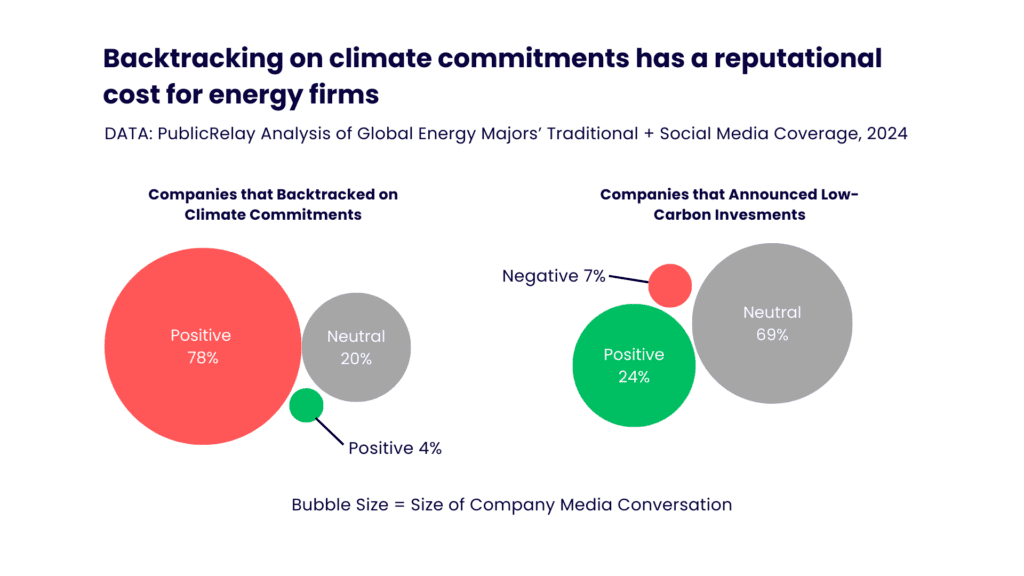
The disparity is clear: rolling back on climate commitments is a critical failure in energy reputation management. Companies that failed to deliver on their pledges faced significant backlash, especially on social media, where climate advocates and engaged communities amplified criticism.
In contrast, companies that took proactive steps (regardless of whether they had previous commitments) garnered more favorable media sentiment. Even when their clean energy initiatives were coupled with continued oil and gas investments, these companies benefitted from the perception that they were taking meaningful action.
The Risk of Overpromising
Backtracking on climate commitments may be worse than making no commitments at all.
Energy companies with bold climate goals but inconsistent follow-through became easy targets for criticism. The gap between promises and actions undermines trust and disrupts effective energy reputation management, leading to questions about a company’s reliability and sincerity.
Conversely, firms without ambitious commitments but actively investing in low-carbon projects avoided this backlash. Their measured approach—taking meaningful actions without overpromising—helped them stay under the radar of critics and maintain trust.
Key Implications for PR Leaders:
- Consistency is Non-Negotiable: Reversing commitments erodes credibility.
- Proactive Communication Matters: Highlight progress on sustainability initiatives, no matter how small, to build positive momentum.
- Crisis Mitigation Requires Speed: Companies that quickly address climate-related criticisms can minimize reputational damage.
Learn how PublicRelay’s data-driven insights can help communicators in the energy sector in navigate these challenges and more.

Navigating the shifting media landscape has become a critical skill for professionals in public relations and strategic communications. As the media world undergoes rapid changes, understanding and adapting to these dynamics is essential.
The media world is in flux. Traditional outlets, social platforms, and emerging formats are reshaping the communications field daily. For communicators, it’s not just a shift—it’s a seismic transformation. Yet these challenges present clear opportunities for those who can adapt. Let’s explore what we’ve heard from leading communicators about what’s happening and why it matters.
Traditional Media: Evolution, Not Extinction
Traditional media’s business model is under immense pressure. Trust in major outlets has waned, newsroom budgets have shrunk, and audiences have migrated to mobile-first and social platforms for news. There is no longer a Walter Cronkite-like, “single source of media”. “Media” is everywhere, which means organization reputation is everywhere.
Communicators are now approaching traditional media as one part of a broader strategy. By balancing relationships with reporters and editors alongside content crafted for digital and social channels, organizations can navigate this fragmented landscape with greater precision.

Think Smaller, Connect Bigger
As large national outlets feel increasingly out of reach or out of touch, the focus on local media has intensified. Community-focused stories resonate deeply, creating more meaningful engagement. Whether it’s hyper-local storytelling or partnerships with regional outlets, tapping into smaller markets can yield outsized reputational benefits.
Local audiences are also more engaged—they’re reading, sharing, and reacting. Organizations that invest in grassroots storytelling often see stronger community ties and enhanced reputations in critical regions.

Ground-Up Communications
Ground-up strategies play an essential role in navigating the shifting media landscape, especially when authenticity and trust are paramount. Building on the power of local connections, the shift away from purely top-down, national PR strategies is redefining how trust is cultivated. Today, success depends on developing relationships from the ground up. Local community engagement, grassroots storytelling, and on-the-ground teams are now central to rebuilding or enhancing support in key regions.
This shift isn’t just a tactical move; it’s strategic. In a polarized and fragmented media environment, audiences crave authenticity. Investments in local communications teams are paying dividends, both in trust and long-term support.
Adapt or Fade: The Fragmentation Dilemma
The increasingly fragmented media landscape requires laser-sharp focus. Messages must be tailored for each platform and each audience. It’s no longer sufficient to “go broad”; you need to go deep where it matters most.
Geo-targeted campaigns, local influencer partnerships, and platform-specific strategies have emerged as critical components of effective communications. The challenge for communicators is to prioritize—strategic adaptation, not one-size-fits-all approaches, will win the day.
Data-Driven Decisions
Data is the compass for navigating the shifting media landscape. It transforms complexity into clarity and guides effective decision-making.
While the fragmentation of media complicates communication efforts, data offers a clear way forward. Social media platforms provide communicators with an abundance of digestible metrics. Impressions, shares, and engagement rates offer a quick glimpse into performance. Yet, these metrics only tell part of the story.
Quantifying traditional media’s ROI often requires more nuanced tools to help communicators track impact across earned and owned channels, while also surfacing actionable insights that drive strategy forward.
Preparing for Media’s New World Order
Declining traditional business models and shifting consumption habits are opportunities to innovate. Diversifying your media mix, amplifying through emerging formats, and measuring everything are no longer optional. They’re mandatory.
The evolving media landscape is daunting, but it’s also rich with potential for those ready to embrace the changes. By prioritizing hyper-local storytelling, harnessing data, and adapting communication strategies to a fragmented audience, communicators can navigate this new era with agility, creativity, and a relentless focus on what’s measurable and meaningful.
Contact us to learn more.

5 Ways to Maximize Your CEO’s Brand Impact
A CEO can influence how the media, stakeholders, and consumers perceive not only their leadership but also the brand they represent. However, recent trends show that while CEOs may be building strong personal brands, they aren’t always translating that success into a positive impact for their companies.
Understanding how to maximize your CEO’s brand impact is key to elevating both their personal standing and the reputation of the organization they lead. Let’s explore how communicators can help their CEO become an asset to their brand.
The CEO Brand Gap: Perception vs. Impact
PublicRelay tracks CEO performance through our CEO Index, which rates CEOs from -10 to +10 on two essential factors:
- Perception: How well the CEO is perceived by the media. This includes the sentiment, reach, and sharing of their personal media mentions.
- Impact: How the CEO’s presence influences their company’s media reputation. This measures the sentiment, reach, and sharing of mentions where both the CEO and company are featured.
What we’ve noticed over the past two years is an interesting trend: while Perception Scores have generally increased, Impact Scores have stagnated. This means that while CEOs may be perceived more positively as individuals, they are becoming less effective at enhancing their company’s reputation.
For communications professionals, this gap is an opportunity to recalibrate. If your CEO’s personal brand is thriving, but your company isn’t seeing a parallel boost in reputation, it’s time to rethink your communication strategy.
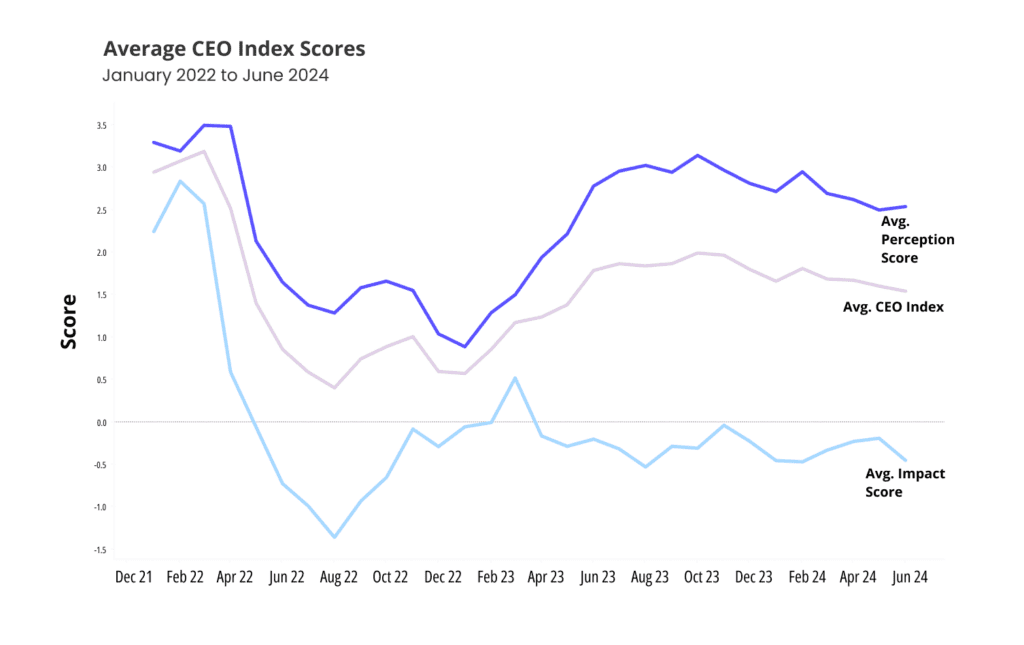
Best Practices to Boost Brand Impact
Here are several actionable strategies to align your CEO’s personal perception with their company’s reputation, ensuring their brand impact is as strong as it should be:
1. Prioritize Company Over Self-Promotion
While building a CEO’s personal brand is important, it should never overshadow the company’s goals. Self-Promoter CEOs, those who focus too heavily on their own narratives, risk becoming disconnected from their organization. Instead, CEOs should weave company successes, values, and innovations into their personal communications. Whether it’s through interviews, social media posts, or speaking engagements, their personal brand should amplify the company’s brand story.
For example, CEOs who leverage media opportunities to highlight company initiatives and industry leadership—not just personal milestones—tend to have higher Impact Scores.
2. Align Thought Leadership with Brand Strategy
A CEO’s thought leadership can be a powerful tool to enhance the company’s reputation. However, it must be strategic. CEOs who speak on broader industry trends, corporate responsibility, or emerging technologies often boost both their Perception and Impact Scores. This is because they position themselves as experts not just on their own company but on the wider business landscape.
Encourage your CEO to engage in thought leadership that aligns with your company’s mission and values. Thoughtful commentary on relevant industry issues can help solidify both their authority and the company’s reputation, driving positive media coverage.
3. Stay Clear of Controversial Coverage
Negative media coverage can be difficult to avoid, but strategic communications can help shield your CEO from scandals that can harm both their personal and company brand. One way to manage this is by doing your best to ensure your CEO doesn’t become a scapegoat. Distance them from high-risk issues and focus on positive storytelling.
Incorporating crisis communication strategies into your CEO’s media interactions can protect their Perception while mitigating damage to your company’s Impact. For example, if a major controversy arises, quick, transparent communication that addresses the issue and highlights the company’s corrective measures can help salvage brand reputation.
4. Leverage Key Media Opportunities
Earnings calls, industry conferences, and interviews are prime opportunities for CEOs to bolster their brand impact. By participating in these high-visibility moments, CEOs can directly influence how their company is perceived. In fact, CEOs who personally engage in earnings discussions often drive positive media sentiment for their companies, as it shows hands-on leadership and transparency. See Google’s Sundar Pichai, for example, who drove positive coverage on the company’s growth after their earnings call in July.
Maximizing media moments means ensuring your CEO’s presence in coverage is both visible and favorable. Position your CEO in the right narratives—those that focus on growth, innovation, and strategic vision.
5. Be Mindful of Social Media Perception
Social media can be a double-edged sword for CEOs. While it offers a direct line to the public, it also opens the door to immediate scrutiny. CEOs with large social media followings may generate significant positive engagement, but they are equally vulnerable to backlash, especially if their posts are seen as self-serving or out of touch with current events. A quick look at Elon Musk can give a deep understanding of how that can go.
Communicators should do what they can to help their CEO craft a social media presence that reinforces the brand’s values. Their messaging should resonate with your company’s mission and connect with stakeholders in meaningful ways, avoiding the pitfalls of excessive self-promotion.
Maximizing Your CEO’s Brand Impact
Ultimately, the most successful CEOs are those who understand that their brand is an extension of their company’s identity. By balancing personal perception with corporate impact, they can drive meaningful change for their organization, not just for themselves.
For PR and Communications executives, the challenge is to guide your CEO’s messaging and media presence in a way that reflects positively on both their leadership and the business.
To effectively do so, you need comprehensive insights into how both the CEO and the company are perceived in the media. PublicRelay offers precise, human-verified insights into sentiment, reach, and sharing, ensuring you have a clear picture of how your CEO’s media presence is influencing your company’s reputation. We also track and measure the impact of your CEO’s mentions, allowing you to tailor communication strategies that elevate both personal and corporate brands.
Contact us to learn more about how PublicRelay can help you maximize your CEO’s brand impact and strengthen your company’s reputation.

The 9 CEO Archetypes that Shape (or Sink) Company Reputation
A CEO is not just the leader of a company—they’re its public face. Whether they’re boosting brand visibility or creating PR nightmares, CEOs hold significant power over how the world views their companies. Through recent analysis of our CEO Index, we’ve identified 9 distinct CEO archetypes that either enhance or erode a company’s brand reputation. Understanding which archetype your CEO aligns with can provide valuable insight into how to manage their influence on the corporate brand.
Included at the end of this blog is a quiz for communications leaders to identify which archetype their CEO falls into, helping you refine your strategy accordingly.
CEO Perception vs. Impact
First, it’s important to understand Perception versus Impact. PublicRelay tracks CEO performance through our CEO Index, which scores CEOs (from -10 to +10) on two essential factors:
- Perception: How well the CEO is perceived by the media. This includes the sentiment, reach, and sharing of their personal media mentions.
- Impact: How the CEO’s presence influences their company’s media reputation. This measures the sentiment, reach, and sharing of mentions where both the CEO and company are featured.
A CEO can have a negative Perception Score, while having a positive Impact Score, vice versa, or somewhere in between. The 9 archetypes are each defined by the types of Perception and Impact scores they have.
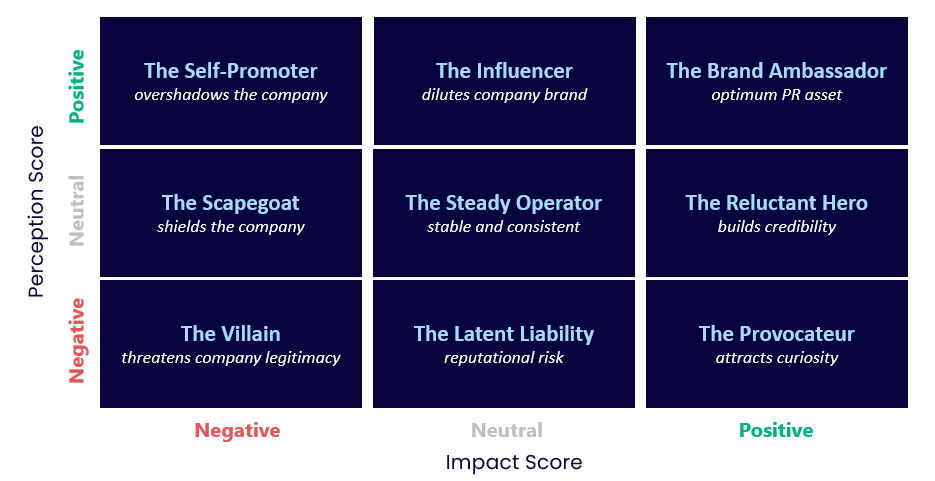
The 9 CEO Archetypes
1. The Self-Promoter
- Features: Known for their strong personal brand, these CEOs often overshadow the company they lead. They blend business, entertainment, and lifestyle media, but the focus remains on them.
- Effects: While their media presence generates short-term buzz, it doesn’t translate to long-term benefits for the company. Employees may feel undervalued, as recognition is tied to the CEO rather than team achievements. Over time, the focus on self-promotion can erode trust in the company’s leadership and values.
2. The Influencer
- Features: Engaging and charismatic, the Influencer CEO is widely recognized as an expert in their field. They are frequently sought out for industry insights, but the media often emphasizes their personal achievements rather than the company’s.
- Effects: While their star power attracts media attention, it often overshadows the company’s brand. This can lead to missed opportunities where the CEO’s media presence could otherwise elevate the entire organization.
3. The Brand Ambassador
- Features: The Brand Ambassador is passionate about the company’s mission and values. They provide transparent insights into company operations and strategy, building trust and credibility.
- Effects: This archetype is highly effective as a PR asset. Their personal reputation enhances the company’s image, attracting customers, investors, and top talent. Employees take pride in their recognition, as it often includes acknowledgment of the team’s contributions.
4. The Scapegoat
- Features: The Scapegoat is often associated with controversy, stepping up to take responsibility when things go wrong. They aim to protect the company and its brand by absorbing the blame.
- Effects: While this CEO’s willingness to accept responsibility can sometimes shield the company from reputational damage, frequent association with controversy raises questions about their overall competence. Over time, this leads to skepticism and damages both the CEO’s and the company’s reputation.
5. The Steady Operator
- Features: The Steady Operator provides consistent, reliable leadership but lacks the flair to capture significant media attention. They focus on delivering factual, straightforward information.
- Effects: Stability and reliability are the hallmarks of this archetype. However, the company may miss opportunities for a dynamic reputation boost due to the CEO’s understated presence. The public sees the company as stable, but without much excitement or innovation.
6. The Reluctant Hero
- Features: Known for making rare, but highly strategic media appearances, the Reluctant Hero focuses attention on the company’s innovations and the team’s contributions.
- Effects: This CEO’s authentic and humble approach builds credibility and trust. The public and media perceive the company as genuine and mission-driven, increasing support. Employees also feel recognized and valued through the CEO’s emphasis on team successes.
7. The Villain
- Features: The Villain CEO is often criticized for poor decision-making and leading the company into controversy.
- Effects: Repairing reputational damage is an uphill battle for this CEO. Their negative perception spills over into the company, making it appear poorly managed and untrustworthy. This typically leads to financial losses and a struggle to regain legitimacy.
8. The Latent Liability
- Features: This CEO may be largely invisible until controversies surrounding their personal behavior or past scandals surface. They appear disconnected from the company’s core mission and values.
- Effects: Although the company may not immediately suffer from this CEO’s negative reputation, their continued presence can gradually erode trust, leading to long-term damage. Communications teams find it challenging to use this archetype as a PR asset, as their media presence poses more risks than benefits.
9. The Provocateur
- Features: The Provocateur is known for bold decisions and outspoken views that generate controversy. However, their vision often drives innovation and change.
- Effects: Despite the initial skepticism, this CEO’s resilience in the face of controversy can eventually shift public perception in their favor. Their ability to generate buzz and attention often puts the company in the spotlight, helping the brand stand out as innovative and forward-thinking over time.
Real-World Examples
Jamie Dimon (JPMorgan): Starting as a Scapegoat in media coverage of JPMorgan’s controversial return-to-office policy and a tough business environment, Dimon transitioned into an Influencer archetype as he distanced himself from scandals and focused on thought leadership. This pivot meant he stayed out of highly shared negative coverage around compliance controversies and more, but his personal brand may now eclipse the bank’s. If he were to leave the organization, his influence would leave with him.
Ryan Lance (ConocoPhillips): Lance is a Reluctant Hero, having managed to avoid being drawn into coverage on environmental and climate change issues companies, all the while strategically appearing in the spotlight to highlight business wins, positioning the company positively without taking much in the way of personal credit.
How CEO Archetypes Shape Brand Strategy
Each of these archetypes presents unique challenges and opportunities for communications leaders. The key to maximizing brand impact is understanding which archetype your CEO aligns with and adjusting your communications strategy accordingly.
Self-Promoters may require media strategies that balance their personal brand with the company’s message.
Brand Ambassadors can be powerful spokespersons for company values, but Villains and Latent Liabilities may require crisis management plans to mitigate their negative perception.
By identifying your CEO’s archetype, you can tailor media strategies to enhance their strengths while mitigating risks.
Understanding CEO archetypes is essential for communications professionals tasked with managing brand reputation. With the right approach, and the right media measurement support, you can leverage your CEO’s strengths to align their personal brand with the company’s goals and protect your organization from reputational risks.
Take the Quiz: Which Type of CEO Are You Working With?
Curious about where your CEO falls in the archetype spectrum? Take this brief quiz to discover their CEO style so you can tailor your communications strategy for maximum brand impact.
1. How does your CEO typically engage with the media?
A) They are the face of the company and often appear in interviews, even in non-business contexts.
B) They are sought after for their expertise and frequently share insights on industry trends.
C) They tend to be in the spotlight mainly during crises or controversies.
D) They provide calm, factual statements and avoid the limelight whenever possible.
2. How do your CEO’s media engagements affect the company’s brand?
A) The CEO’s strong personal brand often overshadows the company’s brand.
B) The company’s brand can sometimes feel secondary compared to the CEO’s personal recognition.
C) The CEO regularly shields the company brand by taking accountability during controversies.
D) The CEO generates little excitement or buzz, but the company is seen as reliable.
3. How do employees perceive your CEO’s media presence?
A) Employees often feel overlooked, as the CEO rarely mentions the efforts of the team in public.
B) They are proud that the CEO is well-respected in the media, but there’s a sense that the CEO avoids getting involved when the company faces controversies.
C) Employees appreciate that the CEO takes public accountability when things go wrong.
D) Employees see the CEO as competent and reliable, though not particularly inspiring.
4. How does your CEO handle controversies or negative publicity?
A) They tend to deflect media focus away from company scandals by drawing attention to themselves instead.
B) They continue to provide industry commentary and thought leadership in the media, but avoid publicly addressing controversies.
C) They step forward, take responsibility, and try to shield the company from further damage.
D) They address the issues calmly and factually, avoiding any dramatic statements or actions.
Results:
If you answered mostly A’s: Your CEO is The Self-Promoter.
Your CEO has a strong personal brand that often overshadows the company. They bridge the gap between business, entertainment, and lifestyle media, but this doesn’t always translate into benefits for the company.
If you answered mostly B’s: Your CEO is The Influencer.
Your CEO is charismatic and widely recognized for their expertise. While they attract a lot of attention, their strong personal brand can sometimes make the company’s brand seem secondary.
If you answered mostly C’s: Your CEO is The Scapegoat.
Your CEO often takes the blame during controversies, acting as a shield for the company. While this can mitigate reputational damage, it can also lead to skepticism about the CEO’s overall competence.
If you answered mostly D’s: Your CEO is The Steady Operator.
Your CEO delivers consistent and reliable leadership without seeking the spotlight. The company is perceived as stable, but there may be missed opportunities to enhance the company’s reputation.

Defense Sector Reputation Risks
The pandemic had substantial negative effects on the global supply chain. With the world still doing its best to adjust to post-pandemic realities, the media remains sensitive to supply chain disruptions. Despite data suggesting that supply chain pressures have eased, news stories continue to frame supply chains as fragile, leaving industries like defense vulnerable to intense media scrutiny.
According to the Global Supply Chain Pressure Index (GSCPI), supply chain pressures have generally trended below the historical average for over a year. Yet media coverage on supply chain disruptions surged by over 100% in Q3 of 2023, reaching pandemic-era levels. This rise in coverage, despite relatively stable conditions, reveals how deep-rooted fears of supply chain instability persist, largely fueled by memories of pandemic-related disruptions.
For the defense sector, these shocks carry an even greater reputational risk. Defense is uniquely challenged by the geopolitical landscape, where global conflicts create unpredictable spikes in demand.
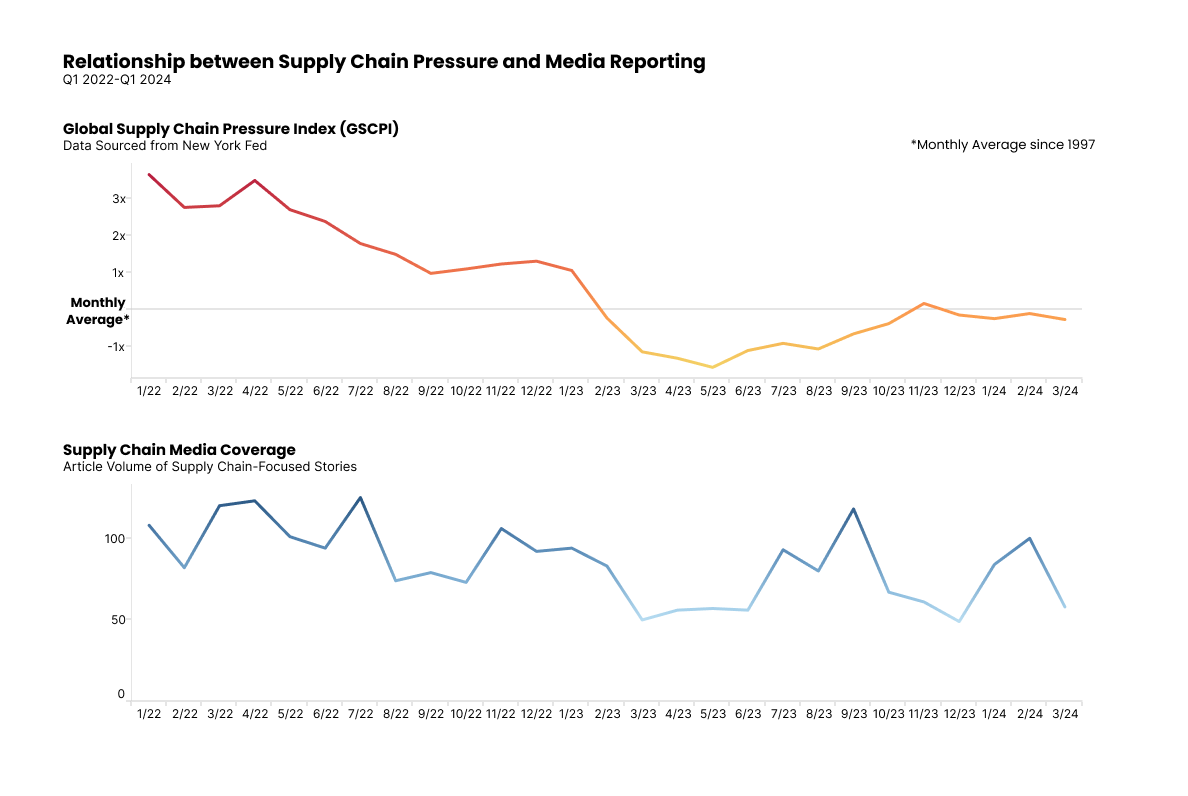
Global Conflicts and Outsized Demand
Throughout 2023, the defense industry faced heightened scrutiny, as supply chain issues featured prominently in nearly one-third of all defense-related media coverage. The nature of defense manufacturing—complex, highly regulated, and dependent on specialized suppliers—exposes the industry to gaps in its supply chain more visibly than in other sectors. Unlike consumer goods, where shortages might result in delayed shipments or backorders, a lapse in the defense supply chain can have far-reaching consequences that could lead to national security risks or international diplomatic repercussions.
With ongoing global conflicts driving outsized demand for items like military aircraft, technology, and more, the defense industry finds itself facing immense pressure to deliver quickly and efficiently. This demand exacerbates any existing vulnerabilities in the supply chain, from sourcing raw materials to securing manufacturing components. Any perceived or actual delays in fulfilling contracts can lead to negative media coverage. This further compounds the pressure on defense firms.
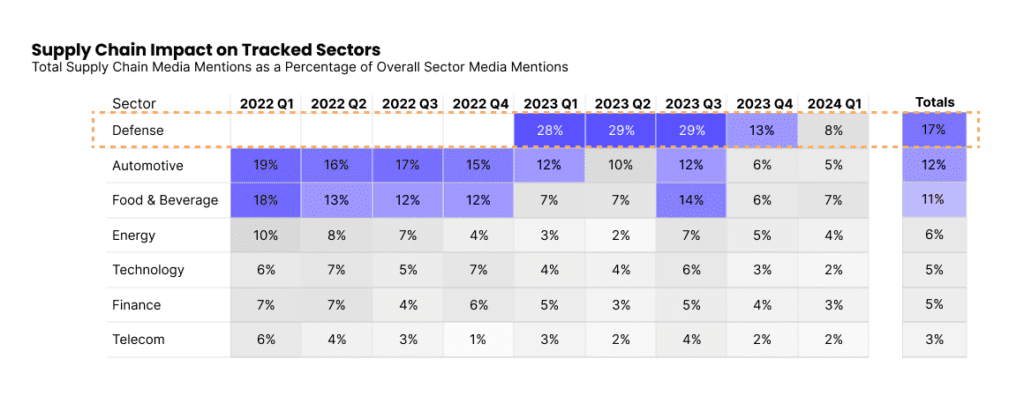
The Media’s Role in Amplifying Concerns
Even though supply chain pressures have been trending below the historical average, the media remains hyper-aware of any disruptions. Coverage tends to spike in response to real or perceived supply shocks, and the defense sector is no exception. For example, when a Boeing 737 Max panel blew out mid-flight, it triggered accusations of unrealistic production standards.
Journalists and analysts, still influenced by the pandemic, are quick to draw parallels between today’s challenges and the more severe disruptions of recent years. In fact, one-third of supply chain stories published since June 2023 (from CNN to Bloomberg to NPR) referenced the pandemic, demonstrating how much the media narrative is still shaped by past crises.
For defense communicators, this presents a significant challenge. Even when supply chain disruptions are minimal, heightened media sensitivity means that any hiccup can quickly become a headline.
The Impact on Defense Sector Reputation
Supply chain shocks are not just operational challenges for defense firms—they are reputational threats. The ability to quickly and reliably deliver products is critical to a company’s standing with stakeholders, including government clients, partners, and the general public. Delays in production or missed deadlines can lead to questions about the company’s efficiency and reliability.
The stakes are high. A damaged reputation in the defense sector can have long-term consequences, from losing critical government contracts to eroding public trust. Defense companies need to communicate effectively during times of supply chain stress, reassuring stakeholders that they are capable of managing disruptions while fulfilling their obligations.
Preparing for the Next Disruption
For PR and communications leaders in the defense sector, the key takeaway is clear: be prepared to respond quickly and strategically to any coverage of supply chain shocks. While current supply chain pressures may be near historical averages, media narratives are often shaped by past disruptions, making it crucial to anticipate how global conflicts or sudden demand spikes could reignite concerns.
PR teams must continuously monitor the media landscape, tracking coverage of supply chain issues and being ready to provide stakeholders with reassurances about the company’s operational capabilities. By staying ahead of the narrative, communicators can protect their brand from undue criticism and ensure that their organization maintains a strong reputation even in times of crisis.
Communicating the ability to meet demands, even in the face of unpredictable global pressures, will be critical to preserving trust and confidence in the defense industry as a whole. As supply chain shocks continue to make headlines, the defense sector must remain vigilant, ensuring that its reputation is as resilient as its supply chain.
Contact us here to learn how PublicRelay can support.

The Olympic Appeal: A Media Opportunity Like No Other
With the 2024 Paris Paralympics set to start soon and focus quickly shifting to the 2026 Winter Games in Milan and the 2028 Games in Los Angeles, many PR and Communications executives are preparing to capitalize on the opportunities the events provide for brands with Olympic media coverage.
The Olympics offer a golden stage for brands to showcase their message to a global audience. As one of the most-watched events globally, the Olympics had 30.6 million viewers in 2024. The sheer number of eyeballs glued to screens worldwide offers an unparalleled platform for brands to showcase their messages.
One company that seems to have benefited greatly in media coverage of their Olympic support was Comcast. Every mention we analyzed was either neutral or positive in tone. In fact, there were glowing accounts of Comcast’s Peacock app coverage, their use of shortform content on social media, and more.
For smaller brands as well, the Olympics can be a game-changing opportunity. A well-executed campaign can introduce a brand to millions, creating lasting impressions that can drive business growth.
However, this high visibility can also attract unwanted attention.
Our analysis of corporate media coverage around the Paris games surfaced some insights that could help communicators make the most of these upcoming opportunities and avoid the potential risks involved.
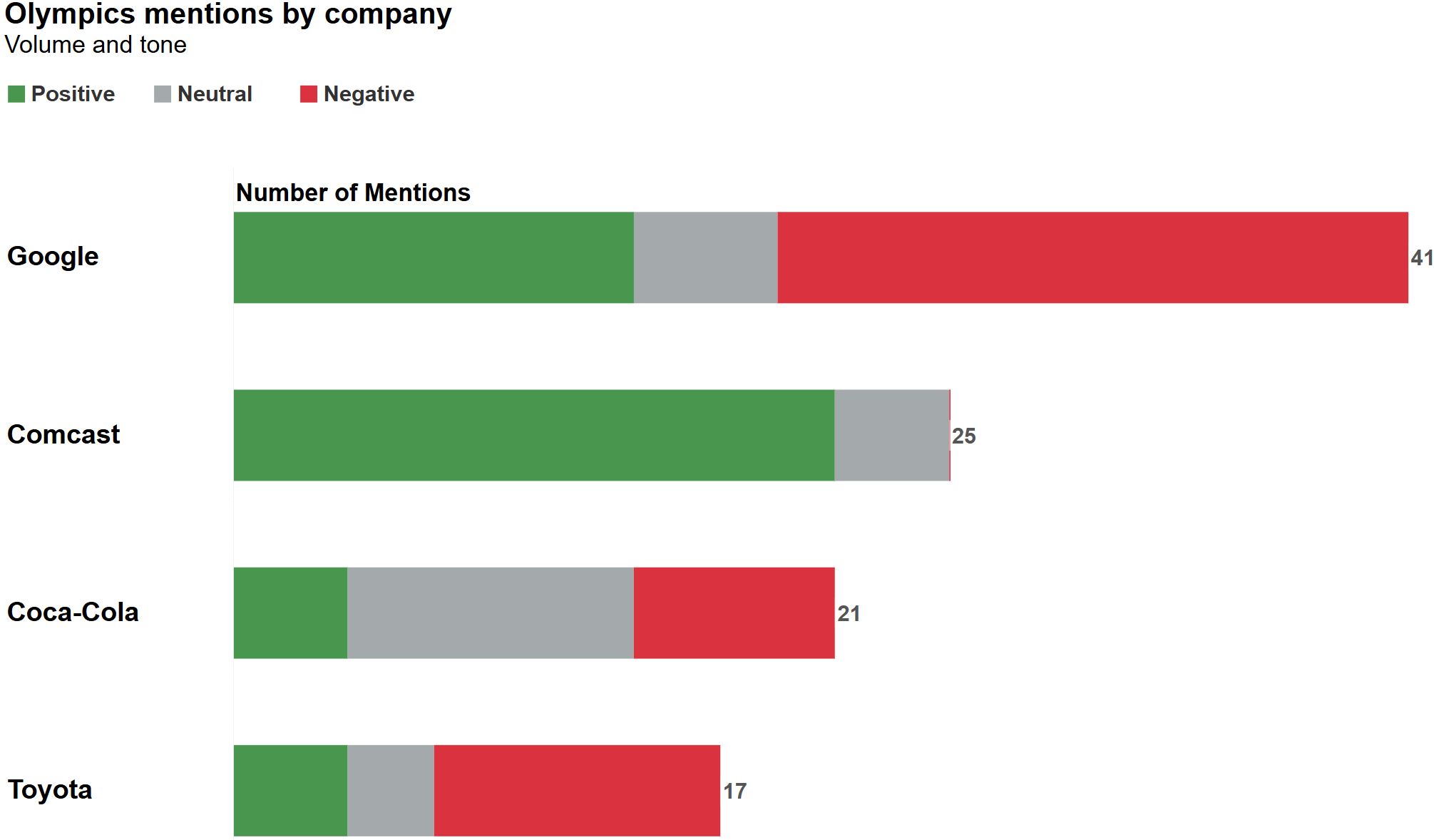
The Dark Side of Olympic Media Coverage
While the Olympics offer immense opportunities, they also come with significant risks. A lot of eyes can be great for a winning campaign – or it can go down in history as an utter failure. Further, controversies that extend beyond sports often surround the games.
The Consequences of a Misfired Campaign
Given the visibility of the Olympics, there are elevated stakes for high media uptake on a brand campaign. A campaign that missteps in tone can have an effect opposite the desired brand impact. This year, one of the more visible misfires was Google’s Gemini advertisement, which Google pulled from the Olympics airwaves after backlash in the media. While it seemed intent to represent a cute interaction between a child and her role model, it was accused of endorsing “automation instead of authenticity” over the use of AI to write a fan letter, something which many could argue goes against the Olympic spirit.
Another example of Olympic sponsorship backlash involves Toyota’s use of hydrogen-powered cars as official transport vehicles during the games. While the initiative intended to showcase Toyota’s commitment to sustainable technology, environmentalists criticized it, arguing that the vehicles were not as green as they appeared. Critics pointed out that hydrogen production often relies on non-renewable energy sources, making the cars less environmentally friendly than their all-electric counterparts. This criticism was covered in major outlets, and serves to highlight the complexities of promoting innovative green technology on a global stage. It also underscores the risk of backlash when a sponsor’s environmental claims do not fully align with public expectations.
We also see this misalignment with Olympics sponsor Coca-Cola. The company was hit with negative coverage on multiple fronts around their support of the Games. At an event deemed “one of the most eco-friendly Games in history”, Coca-Cola, came under fire from environmental groups and athletes alike for its use of plastic, warranting an official response from the company. Then, in another instance, health experts called Coca-Cola’s role as a sponsor in general into question. They claimed the organization was “sportswashing” its generally unhealthy products by aligning with the athletic endeavors of the Olympics.
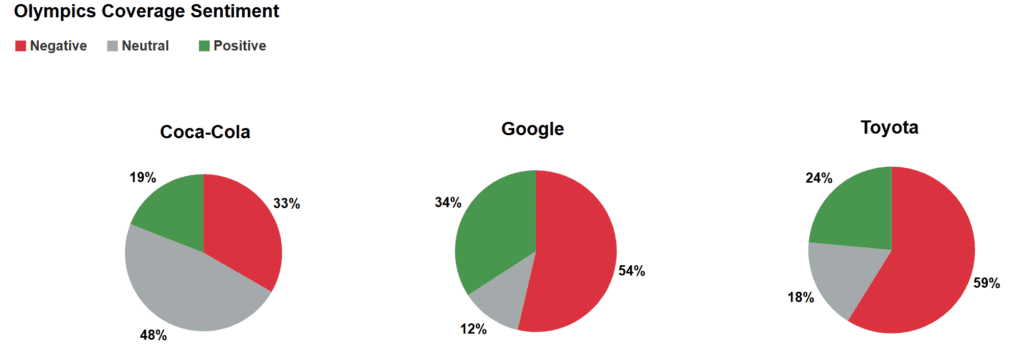
The Decline of the Olympic Brand
Toyota again made headlines for its decision to end its sponsorship of the Olympics after Paris 2024. The company’s withdrawal from Olympic sponsorship highlights two significant reputational risks associated with sponsoring the games: geopolitics and athlete welfare.
Firstly, the geopolitical landscape surrounding the Olympics has become increasingly fraught. The games are often mired in scandals, corruption, and controversies over host nations’ human rights records. Toyota, like many global brands, found its reputation at risk by being linked to these issues. This was especially true during the Tokyo 2020 games, which faced heavy criticism for proceeding amid the Covid pandemic and local corruption scandals. Increasing geopolitical instability means Olympics sponsors are likely to face more reputational challenges related to these issues in the future.
Secondly, Toyota was concerned about how its sponsorship money was allocated, with reports indicating that funds were not effectively used to support athletes or promote sports. This misalignment with the company’s values led Toyota to conclude that the risks of continuing its sponsorship outweighed the potential benefits.
In Summary: The Complex Landscape of Olympic Branding
The Olympics present a unique media opportunity for corporate branding, but the landscape is fraught with challenges. The Olympics has two main types of PR risks:
- External risks in terms of the controversies the Olympics brand itself attracts, and –
- It is also likely to magnify preexisting reputational issues due to the heightened visibility.
While at face value the Olympics bring about an image of excellence, friendship, and respect – values any company would be proud to associate with – global realities and stakeholder expectations adds more to the picture that communications leaders should be aware of.
To learn more about our research and analysis, contact us here.

The alignment between a company’s public statements and its actions has never been more crucial. Reputation-reality gaps, i.e., inadequate actions to back up PR statements, are increasingly seen as hypocritical, damaging brand reputation, trust, and loyalty. An example that underscores this is the response to Mondelez following the invasion of Ukraine.
The company publicly announced intention to scale back operations in Russia, aligning with global sentiments against Russia and showcasing solidarity with the Ukrainian cause. However, despite its statements, the company continued to generate revenue and pay taxes in Russia. This discrepancy between its public commitments and ongoing business activities created a significant reputation-reality gap.
Consumers, especially in Europe, took notice. The perceived hypocrisy led to boycotts of Mondelez products across the continent. These boycotts weren’t just a fleeting reaction but a clear message from the public: companies must practice what they preach.
The situation with Mondelez (and Unilever, and Heineken, and more) serves as a stark reminder of the importance of consistency between words and actions. For brands, maintaining credibility requires more than just making the right statements.
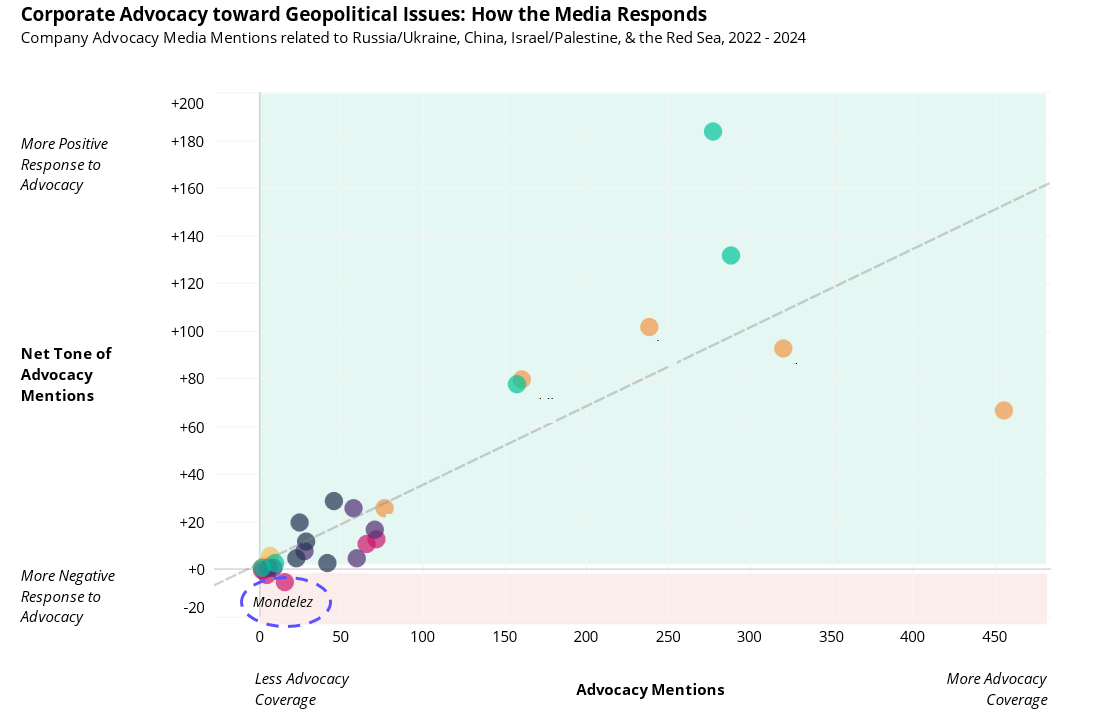
The Importance of Alignment
In the age of information, consumers are more informed and empowered than ever before. They have access to a wealth of information at their fingertips and are increasingly holding companies accountable for their actions. Social media platforms amplify their voices, enabling them to share their opinions and mobilize others quickly.
For businesses, this means that the stakes are higher. Public statements are scrutinized, and any discrepancy between what a company says and what it does can quickly become a focal point for criticism.
When Mondelez announced its decision to scale back operations in Russia, they likely intended to align with global sentiments and show support for Ukraine. However, the continued revenue generation and tax payments in Russia told a different story. The gap between words and actions was seen as hypocritical, and the backlash was swift.
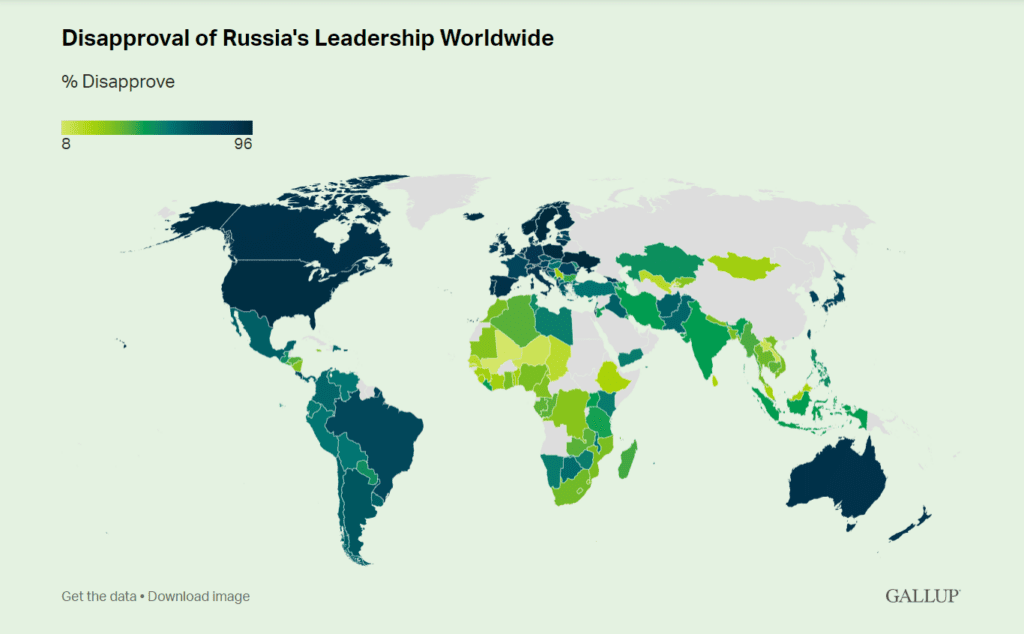
The Consequences of a Reputation-Reality Gap
The boycotts of Mondelez products in Europe highlight the tangible consequences of a reputation-reality gap. Boycotts can lead to a significant loss of revenue and market share. More importantly, they can damage the long-term relationship between a brand and its consumers.
When consumers feel that a company has been dishonest, their trust in that brand erodes. Trust is a fundamental component of brand loyalty. Once it’s broken, it’s incredibly challenging to rebuild. This is especially true in today’s competitive market, where consumers have numerous alternatives to choose from.
Moreover, the impact of a damaged reputation extends beyond just consumers. Investors, partners, and employees also take note of these discrepancies. A company that is perceived as hypocritical may struggle to attract and retain top talent. Investors may lose confidence in the company’s leadership and long-term strategy. Partners may reconsider their relationships, fearing that association with a discredited brand could harm their own reputation.
Lessons for Communicators and Business Leaders
The Mondelez case offers several important lessons for communicators and business leaders:
- Ensure Consistency Between Words and Actions: It’s not enough to make the right statements. Statements must align with actions, and communicators should inform other leaders within the organization of the importance of this consistency.
- Be Transparent: If there are challenges or limitations to what a company can do, it’s better to be upfront about them. Transparency builds trust and shows that the company is committed to being honest with its stakeholders.
- Monitor and Respond to Public Sentiment: It’s essential to stay attuned to public sentiment. Companies need to monitor media to understand how their actions and statements are being received. Prompt and appropriate responses can help mitigate potential backlash.
- Prepare for Crises: Despite the best efforts, crises can still occur. Companies need to have a robust crisis management plan in place to respond quickly and effectively. This includes having a clear communication strategy to address any gaps between words and actions.
Moving Forward
The case of Mondelez is a powerful reminder of the importance of aligning public statements with actions. In today’s interconnected world, consumers, investors, and other stakeholders are more vigilant and vocal than ever before. They expect companies to live up to their commitments.
For companies, this means that maintaining credibility requires a concerted effort to ensure that actions consistently align with words. It’s about being genuinely committed to the values and principles that the company espouses.
By doing so, companies can not only avoid the pitfalls of a reputation-reality gap but also build stronger relationships with their stakeholders. This in turn can lead to greater long-term success.
The high cost of a reputation-reality gap underscores the need for companies to act with integrity and consistency. The backlash faced by Mondelez and other companies serves as a cautionary tale for all businesses and a reminder that in today’s world, actions speak louder than words.
To learn more about ways you can measure and manage your reputation, contact us here.